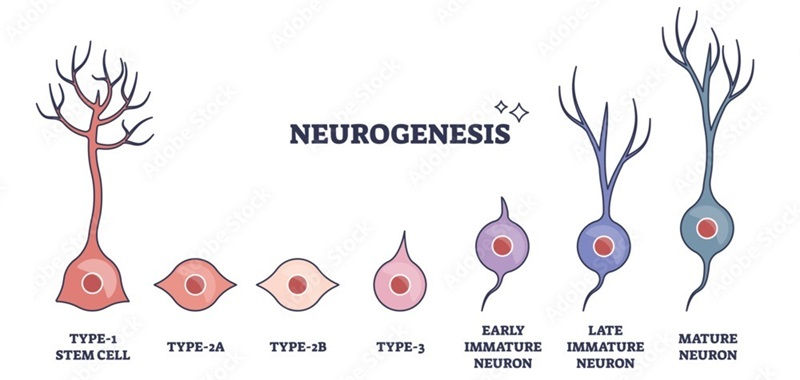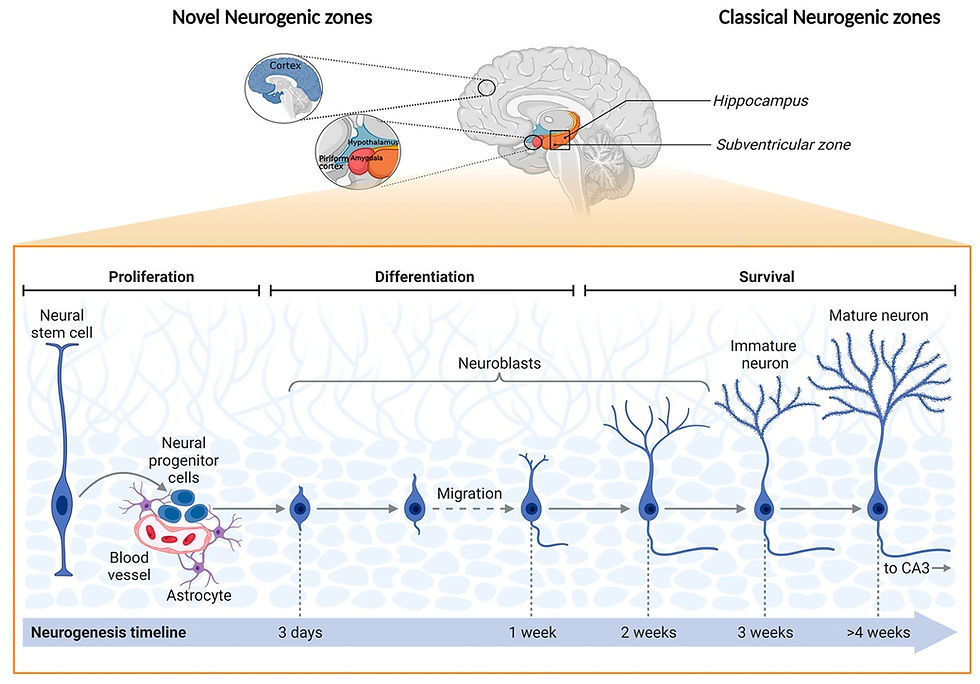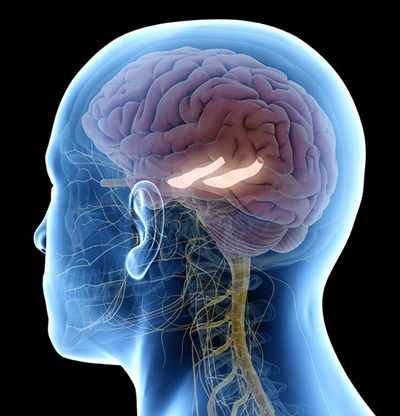🧠 You as an Adult, Can Grow New Brain Cells. Here's How!
- ketogenicfasting

- Jul 28
- 5 min read
Updated: Aug 2
Neuroscientist Sandrine Thuret says that we adults can grow new neurons, and she offers research and practical advice on how we can help our brains better perform neurogenesis—improving mood, increasing memory formation and preventing the decline associated with aging along the way.
Can We, as Adults, Grow New Neurons? 🧠✨
For decades, the prevailing belief in neuroscience was that the human brain stops producing new neurons shortly after childhood. This assumption led to a deterministic view of aging, where memory decline, cognitive fatigue, and mood disorders were seen as inevitable consequences of growing older. However, modern neuroscience has radically shifted this perspective. Today, compelling evidence supports the idea that adult neurogenesis—the birth of new neurons—does occur, particularly in the hippocampus, the brain region critical for learning, memory, and emotional regulation.
One of the leading voices in this field is neuroscientist Sandrine Thuret, who argues that not only do adult brains produce new neurons, but that we can also take proactive steps to support and enhance this process. In her TED Talk and academic work, Sandrine Thuret explains how neurogenesis can improve mood 😊, boost memory 🧠, and protect against cognitive decline 🕰️. Her message is clear: the adult brain is far more dynamic and regenerative than once thought.
🧬 The Science of Adult Neurogenesis

Here’s a very simple explanation of the stages of neurogenesis shown in the diagram:
Type-1 Stem Cell 🧬The “starter” cell that can become a neuron.
Type-2A & 2B Cells 🔄These are in-between stages as the stem cell starts changing.
Type-3 Cell 🧪A more committed cell, now on its way to becoming a neuron.
Early Immature Neuron 🌱A baby neuron starting to take shape.
Late Immature Neuron 🌿Grows branches and starts connecting.
Mature Neuron 🌳A fully formed brain cell ready to send and receive signals.
In short: stem cell → baby neuron → mature, working neuron. 🧠✨
Adult neurogenesis primarily occurs in two regions of the brain (see the :
🔹 the subventricular zone (lining the lateral ventricles), and
🔹 the subgranular zone of the hippocampal dentate gyrus.

The latter is especially important, as the hippocampus is central to memory 📝 and emotional regulation 💬. Through advanced imaging and animal studies, scientists have observed the formation of new neurons in adult brains, with some of these cells integrating into existing neural circuits and contributing to cognitive functions.
Sandrine Thuret emphasizes that neurogenesis is not just a fascinating phenomenon—it’s a key to maintaining a healthy, adaptable mind. A lack of neurogenesis has been linked to depression 😔, anxiety 😟, and memory loss. In contrast, increasing neurogenesis correlates with better mood, learning capacity, and emotional resilience 💪.

🛠️ Supporting Neurogenesis: What We Can Do
The good news? 🎉 Adult neurogenesis is highly responsive to lifestyle choices. Here are five proven ways to promote it:
🏃 Exercise
Aerobic exercise like running increases blood flow 💓 to the brain, reduces inflammation 🔥, and boosts BDNF (brain-derived neurotrophic factor)—a key protein for neuron growth.
A neurotrophic factor is a type of protein that supports the growth, survival, and function of neurons (nerve cells). These proteins are essential for brain development, repair, and ongoing neural plasticity (the brain's ability to adapt and change).
One of the most well-known neurotrophic factors is Brain-Derived Neurotrophic Factor (BDNF). It plays a crucial role in:
🧠 Promoting neurogenesis (the growth of new neurons)
🔁 Enhancing synaptic plasticity (improving how well neurons communicate)
🛡️ Protecting existing neurons from damage
📚 Improving learning and memory
BDNF levels can be increased through:
Aerobic exercise 🏃
Healthy diet (e.g., omega-3s, curcumin, polyphenols) 🥗
Deep sleep 😴
Mental stimulation 🧠
Stress reduction 🧘
In short, neurotrophic factors are like "fertilizer" for your brain—helping it grow, heal, and stay resilient. 🌱
🥗 Diet
A neurogenesis-friendly diet includes:
omega-3s (like in salmon 🐟),
polyphenols (in blueberries 🫐 and dark chocolate 🍫),
turmeric 🌱, and
green tea 🍵.
Intermittent fasting or caloric restriction may also trigger brain cell regeneration.
😴 Sleep

Deep, restorative sleep helps consolidate memory and supports brain cell growth. Sleep deprivation 💤 stunts neurogenesis, especially in the hippocampus.
The brain has two hippocampi—one in each hemisphere—which play a key role in forming and storing both short-term and long-term memories. They also help facilitate communication between neurons and with other regions of the brain.
🧠 Learning and Novelty
Challenging your brain with new activities encourages neuron survival and integration.
learn a new language 🗣️,
play music 🎶, or
explore unfamiliar places 🌍
🧘 Stress Reduction
The following relaxation techniques help create a nourishing environment for new brain cells by lowering stress hormones like cortisol and enhancing conditions that support neurogenesis, particularly in the hippocampus:
🧘♂️ 1. Mindfulness Meditation
Calms the nervous system, lowers cortisol, and increases gray matter in the hippocampus.
🌬️ 2. Deep Breathing (Diaphragmatic Breathing)
Slows heart rate, activates the parasympathetic nervous system, and reduces stress signals in the brain.
🧘 3. Yoga
Combines movement, breath, and mindfulness to regulate cortisol and increase brain-derived neurotrophic factor (BDNF), which supports neuron growth.
🙏 4. Prayer or Spiritual Contemplation
Reduces anxiety, enhances feelings of safety and connectedness, and promotes a calm mental state conducive to brain healing and regeneration.
🎧 5. Guided Visualization or Relaxation
Guided Visualization (also called guided imagery) is a relaxation technique where you mentally picture calming, peaceful, or healing scenes—often with the help of a narrator or audio guide—to reduce stress and promote well-being. 🌿🧘♀️ Guided Visualization activates the parasympathetic nervous system (rest-and-digest), reduces anxiety, heart rate, and stress hormones, promotes theta brainwave activity, calming the mind and helping integrate positive emotional states that support neuroplasticity and supports a brain environment favorable for neurogenesis.
🌿 6. Time in Nature (Forest Bathing / Shinrin-Yoku)
Lowers cortisol, reduces inflammation, and enhances mental clarity—all supportive of neurogenesis.
😌 7. Progressive Muscle Relaxation (PMR)
Releases physical tension and signals the brain that the body is safe, helping neurons thrive.
🧘♂️ How to do it:
Find a quiet space and sit or lie down comfortably.
Start at your feet:
Tense the muscles tightly for 5–10 seconds (e.g., curl your toes).
Release for 20–30 seconds and feel the tension melt away.
Move upward: calves, thighs, buttocks, abdomen, chest, hands, arms, shoulders, neck, and face.
Breathe slowly and deeply throughout the process.
🎶 8. Listening to Calming Music
Lowers stress, regulates mood, and encourages neuroplastic changes in emotional and memory-processing regions.
These techniques support the ideal internal environment for new neurons to grow, mature, and integrate into the brain's existing networks. Practicing them regularly is a powerful way to protect and enhance your cognitive and emotional health. 🌱🧠✨
🔄 Rethinking Aging and Brain Health
The idea that our brains can grow new cells into adulthood reshapes how we think about aging 🧓🧑🦳. Cognitive decline is no longer an unchangeable fate. Brain health isn’t just genetic—it’s a reflection of how we live. By making smart lifestyle choices, we can protect and even enhance our brain function over time. 🕊️
This hopeful shift has real implications for fighting mood disorders, age-related memory issues, and neurodegenerative diseases like Alzheimer’s.
🧩 While more research is needed, the message is clear: a proactive lifestyle can keep your brain young and vibrant. 🌟
✅ Conclusion
Yes—we can grow new neurons as adults!
🧠💥Thanks to the pioneering work of neuroscientists like Sandrine Thuret, we now understand that adult brains are capable of regeneration. By exercising, eating right, sleeping well, staying curious, and managing stress, we can actively support this incredible process. These habits not only improve mood and memory but also help safeguard our brains against aging.
In embracing this truth, we empower ourselves to live healthier, more mentally vibrant lives—at any age. 🌱💪✨




Comments